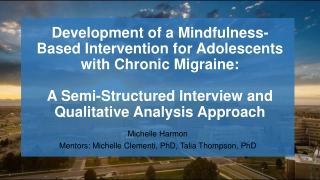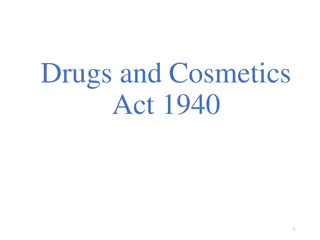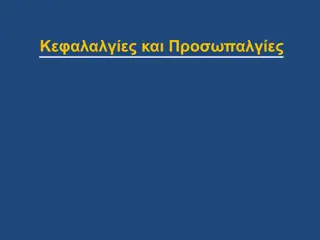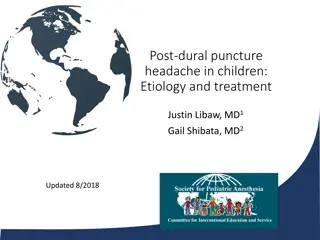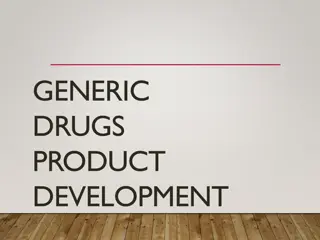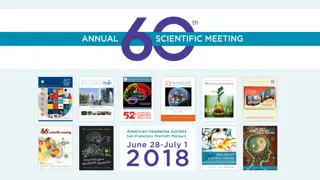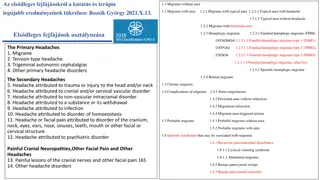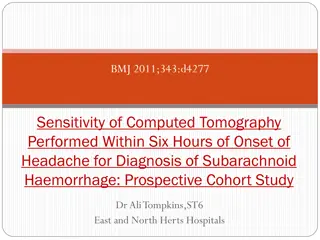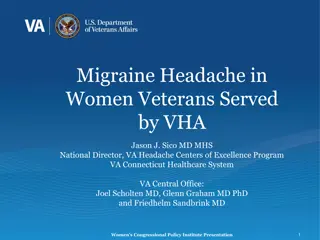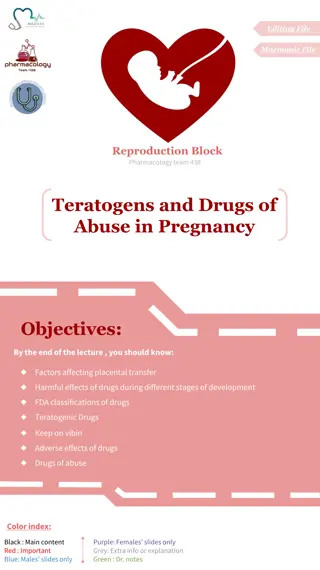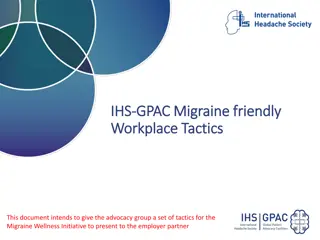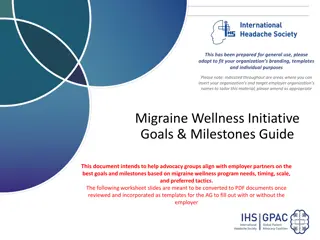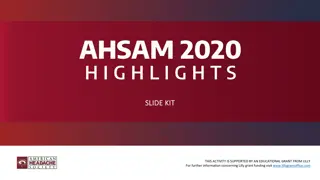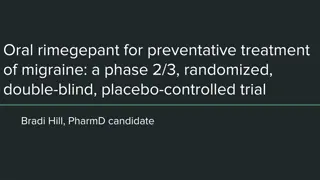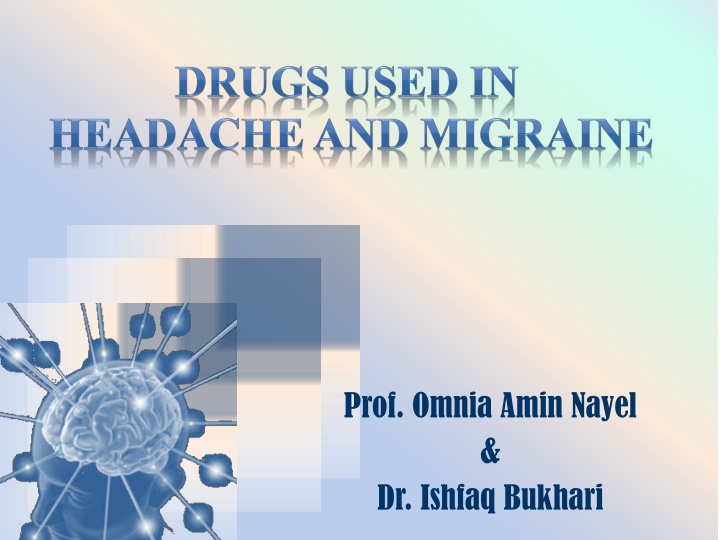
Different Types of Headaches and Their Treatment
Learn about the classification of primary and secondary headaches, symptoms of migraines, and the phases of a migraine attack. Discover the drugs used to prevent and treat migraines along with their pharmacokinetics and toxic profiles.
Download Presentation

Please find below an Image/Link to download the presentation.
The content on the website is provided AS IS for your information and personal use only. It may not be sold, licensed, or shared on other websites without obtaining consent from the author. If you encounter any issues during the download, it is possible that the publisher has removed the file from their server.
You are allowed to download the files provided on this website for personal or commercial use, subject to the condition that they are used lawfully. All files are the property of their respective owners.
The content on the website is provided AS IS for your information and personal use only. It may not be sold, licensed, or shared on other websites without obtaining consent from the author.
E N D
Presentation Transcript
Prof. Omnia Amin Nayel & Dr. Ishfaq Bukhari
ILOs Differentiate between types of headache regarding their symptoms, signs and pathophysiology. Recognize drugs used to prevent migraine Identify drugs used to rescue and abort migraine Elaborate on the pharmacokinetics, dynamic and toxic profile of some of these drugs.
Pain anywhere in the region of the head or neck It is caused by disturbance of the P Pain Sensitive Structures around the brain Within the cranium Outside the cranium ( blood vessels, meninges, cranial nerves) (the periosteum of the skull, muscles, nerves , arteries ,veins, subcutaneous tissues ,eyes, ears and other tissues)
Classification Primary: Primary: Migraine, tension type headache, cluster headache, trigeminal and others where cause in unknown Secondary: Based on the etiology Trauma: of head or neck Vascular disorders: ischeamic stroke, intracrainial hemorrhage. Disease: intracranial tumors,infection, Homeostasis disorders: high BP, fastening, hypothroidsm. Others Treat the etiology
Recurrent attacks of throbbing headache Unilateral / or on both sides Lasting from > 2 up to 72 hrs. + Preceded (or accompanied) by AURA Perceptual disturbance of motor < sensory nature visual [ Photophobia ( sensitivity to light) ] auditory [ Phonophobia ( sensitivity to sound) ] olfactory unpleasant smell . Sensory; abnormal sensation of at face,extremeties. Develops over 5-20 min. & last fewer than 60 min. Aura: flashes of light, blind spots or tingling in your arm. Migraine pain is usually on one side of head with facial and neck pain and nausea and vomiting.
Phases of Migraine 1. Prodrom Phase; a change in mood or behavior (irritability, neck stifness) that starts hours or days before headache. It is experienced by 60% of migraineurs. 2. Aura Phase; Sensory > motor symptoms starts 5-20 min before the migraine attack. It is experienced by 20% of migraineurs. 3. Headache Phase; moderate to severe pain, anorexia, vomiting, Intolerance to light, sounds, odors Blurry vision /Blocked nose /Pale face Sensations of heat or coldness /Sweating /Tenderness of the scalp with activity + 4. Postdrom Phase: still not normal, either; More likely fatigued irritability /impaired concentration /scalp tenderness /mood changes / GIT symptoms,
migraine_clinical_features Curtain like effect over one eye With Aura [20%] Without Aura [80%]
Migraine Triggers Aged cheese, Alcohol, Chocolate, Caffeine, Hot dogs, Avocado, Fermented or pickled foods, Yeast or protein extracts, Aspartame. Hormonal changes Diet Stresses Climate Diseases Antibiotics, Antihypertensives, H2 blockers, Vasodilators, Oral contraceptives Therapy Life Style Theories
Migraine Causal Theories Vascular Triggers Cortical Spreading Depression Intracranial vasoconstriction migraine aura focal ischemia mediators rebound vasodilatation permeability & leak inflammatory reaction activates perivascular nociceptive nerves migraine headache Neurovascular theory ? Mediators [ Serotonin ] It throbs as blood flow at these sensitive area with each heart beat Dopaminergic Hypersensitivity
Migraine Causal Theories File:Cortical spreading depression.gif Vascular Cortical Spreading Depression Triggers Release K / glutamates Creates a slowly well-defined depolarizing wave depolarize adjacent tissues propagating at a rate of 2-6 mm/min vasoconstriction migraine aura activate trigeminovascular complex vasodilation migraine headache Neurovascular theory ? Mediators [ Serotonin ] Dopaminergic Hypersensitivity Which is Pry Which is secondary
Stimulation of the trigeminal nerve causes the release of vasoactive peptides; this is responsible for the head pain, as well as the facial and neck pain, experienced during migraine
TREATMENT STRATEGY ACUTE ATTACK Controls attack. PREVENT RECURRENCE recurrence frequency, severity, duration & / or disability responsiveness to abortive therapy N.B. Full effect of therapy needs several weeks to manifest & should continue for 6 m. & can be repeated RESCUE THERAPY ABORTIVE THERAPY Non-specifically target individual symptoms i.e. alleviating pain, emesis and associated symptoms They specifically target pathways of migraine by meningeal dilatation & neural activation via 5HT1 agonism stopping headache as it is evolving. Abortive medications > effective if taken early, just before the pain starts, losing effectiveness once the attack has begun So they must be rapidly acting Severe/ Disabling i.e. Mild-Moderate
TREATMENT of Acute Attack RESCUE THERAPY NSAIDs / Aspirin< Acetaminophen Non-opioid: agonist; tramadol Analgesics + Gastro-prokinetic Absorption & bioavailability of abortive therapy Dopamine Antagonists Antiemetics Domperidone Phenothiazines Promethazine 5HT3 antagonists Ondanseteron Granisetron Dopamine antagonists + Sedation Antihistamine + Anticholinergic H1 antagonist Meclizine Others; Steroids
TREATMENT of Acute Attack Help Prokinetics; Domperidone ABORTIVE THERAPY Absorption
TREATMENT of Acute Attack 5HT1 AGONISTS > selective ABORTIVE THERAPY TRIPTANS PARTIAL AGONISTS non-selective ERGOTS
ERGOTS TREATMENT of Acute Attack ABORTIVE THERAPY Product of Claviceps purpurea; a fungs growing on rye & other grains Non-Selective Agonism at 5HT1receptors release of vasodilating peptides excessive firing of nerve endings At blood vessels vasodilation & stretching of the pain endings Partial agonist effect on -adrenoceptors vasoconstriction Antagonist to some dopaminergic & serotonergic receptors Dihydroergotamine Ergotamine tartarate Nasal spray, inhaler & injectable forms (good to use if patient is vomiting) Oral, sublingual, rectal suppository, inhaler Caffeine Cafergot
ERGOTS Ergotamine tartarate Oral absorption Sublingual Rectal suppository Elimination Excretion Despite t1/2 nearly 2 hours, ergotamine produces vasoconstriction 24 hours or longer due to high and long tissue binding ability. Dihydroergotamine Incomplete (erratic) + slow low bioavailability Better bioavailability Extensive hepatic 1st pass metabolism 90% of metabolites in bile Given parenterally, Dihydroergotamine is eliminated more rapidly than ergotamine, presumably due to its rapid hepatic clearance Indications They are only used to abort the attacks [ Exception Dihydroergotamine can be given for severe, recurrent attacks ] Their use is restricted to patients with frequent, moderate attack or infrequent but severe attacks.
ADRs ERGOTS GIT upset Feeling of cold and numbness of limbs, tingling anginal pain due to coronary spasm, and disturbed cardiac rhythm ( tachycardia or bradycardia ) Prolong use rebound headache due to vasodilatation followed by vasoconstriction. Prolong use and high dose paraesthesia (tingling or burning sensation) Contraindications Pregnancy; fetal distress and miscarriage (ergot is uterine stimulant) Peripheral and coronary vascular diseases Hypertension Liver and kidney diseases prophylaxis of migraine. In concurrent use with triptans( at least 6 hrs from last dose of tryptans or 24 hrs from stopping ergotamine and -blockers
TREATMENT of Acute Attack TRIPTANES ABORTIVE THERAPY Selective Agonism at 5HT1 receptors Same as discussed for ergotamine except that triptans are more selective as serotonergic agonist. No 1, 2, adrenergic , dopamine or muscarinic receptors. SUMATRIPTAN Present in nasal spray, and injectable forms Oral bioavailability low / Subcutaneous bioavailability is 97%, peaks after 2 min & t1/2 nearly 2 hours (good for patient with vomiting) ZOLMITRIPTAN Oral bioavailability 40%, peaks after 2 hrs & t1/2 nearly 3 hours NARATRIPTAN Present in addition + Oral preparations Oral bioavailability 70%, peaks after 2 hrs & t1/2 nearly 6 hours Present in nasal spray, and injectable forms
Indications TRIPTANES To abort attacks in patients with frequent, moderate or infrequent but severe attacks. In cluster headache ADRs most of adv are the same as with ergot but triptans are better tolerated. Mild pain and burning sensation at the site of injection. Vasospasm, Ischemic heart; Angina and Arrhythmias ZOLMITRIPTAN Chest & neck tightness Somnolence Contraindications Peripheral vasospastic diseases Uncontrolled hypertension History of ischemia Cerebrovascular disorders In concurrent use with ergots or others inducing vasospasm In concurrent use with MAOIs, lithium, SSRIs, . (5HT increased to toxic level)) Renal or hepatic impairment NARA > RIZOTRYPTAN
DECIDING WHETHER BETTER WITH A TRIYPTAN OR WITH DHE. (Enlarge Slide) For patients with headache episodes lasting 2 or 3 days at a time, DHE is often the optimal choice because it has longer t1/2 For patients with migraines a day or less and need rapid relief of pain, tryptans are often a better choice The form of drug preparation could influence the choice Injectable sumatriptan reaches Tmax the fastest followed by DHE nasal spray and rizatriptan
CHOOSING A TRIPTANS Differences in the time to peak blood concentration Tmax, equates with faster relief of pain. Differences in t1/2 a clinical effect in terms of recurrence of headache For extremely fast relief within 15 min. injectable sumatriptan is the only choice. If onset could start within a couple of hrs, oral rizatriptan, zolmitriptan, eletriptan, or sumatriptan nasal spray are appropriate choices If expected re-dosing is needed & / or recurrence of headache Naratriptan , frovatriptan, have slower onset, fewer side effects, and a lower recurrence rate
TREATMENT STRATEGY ACUTE ATTACK PREVENT RECURRENCE Antispastic muscle relaxants; Botulinum toxins, Tizanidine Antiepileptics; Block Na channel & augment GABA at GABA-A receptors Topiramate; Valproic; Gabapentin ? Antidepressants TCA; amitryptylin and nortryptyline SSRIs ? Antihypertensives blockers; propranolol Ca Channel Blockers .Propranolol is commonly used in pophylaxis of migrain attack
L L G G U U O O C C O O K K D D

